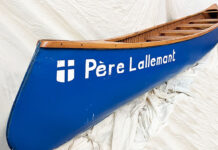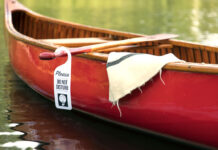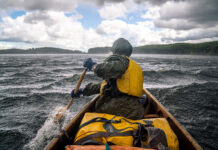Locked in Canada’s intellectual property vaults are something in the order of 150 patents having to do with canoes and kayaks, the earliest of which were taken out by builders in the mid-19th century. They’ve accumulated at a slow rate—some of the more recent innovations include the packsack canoe (2001), outboard canoe seat (2002), heated paddle shaft (2009) and pedal-propulsion system (2010).
You’d be forgiven for thinking that very little has happened in the world of canoe innovation and even with the craft itself, since maritime history began. But you’d be wrong.
A Strange Source Of Canoe Innovation
Breakthroughs in canoe design and construction techniques over the years that have resulted in leaps in the utility, elegance, durability, buildability and popularity of our much-loved vessel.
By far, the strangest source of canoe innovation in modern times has been war. War has been responsible for the strong and steady growth in canoeing of all kinds since WWII. Even Bill Mason’s first canoe, a Plycraft, was made thanks to wood laminating technology perfected in the construction of de Havilland Mosquito bombers.
It was slick aluminum fabrication technology used to produce military aircraft that allowed the Grumman Aircraft Company to create a peacetime fuselage—the enduring Grumman canoe. Thanks to the low cost and ease of manufacture that comes with mass production, canoeing became more accessible in North America and single blades flooded the water.
Similarly, we owe the best canvas-covered sectional canoe the world has ever seen to the Link Trainer, a flight simulator designed to mass educate young pilots without crashing too many real planes in the process. Edwin Albert Link, an ingenious inventor, parlayed air piston technology from his family’s organ business in Indiana into creating one of the first flight simulators. More than 500,000 pilots were trained in the U.S. alone.
When the war came to a close, Link adapted the same wood-trimmed phenolic resin panels with canvas cover, used in the simulator production, to the manufacture of 10-piece sectional Linkanoes with commercial success. The patent is still in effect today.

More recently, cloths, resins and plastics developed for war tools and equipment have continued to further the path of the paddle. Best known of these materials are aramid synthetic fibers, such as Kevlar and Twaron, the staple of bulletproof garments and portable armor plating.
These war-driven cloth and resin manufacturing techniques made it possible to mold canoes with incredible strength-to-weight ratios and offer modern designs. Not only can canoeists now paddle and portage farther with less effort, they can even do it alone—solo-carry ing a wood canoe requires the strength of a marine.
While flipping through this year’s edition of the Paddling Buyer’s Guide, you might find it strange to consider how our peaceful little boats have evolved by leaps and bounds thanks to an industrial production cycle powered by global conflict.
James Raffan is the former executive director of the Canadian Canoe Museum and a regular contributor to Canoeroots.
 This article first appeared in the 2015 Paddling Buyer’s Guide. Subscribe to Paddling Magazine and get 25 years of digital magazine archives including our legacy titles: Rapid, Adventure Kayak and Canoeroots.
This article first appeared in the 2015 Paddling Buyer’s Guide. Subscribe to Paddling Magazine and get 25 years of digital magazine archives including our legacy titles: Rapid, Adventure Kayak and Canoeroots.








